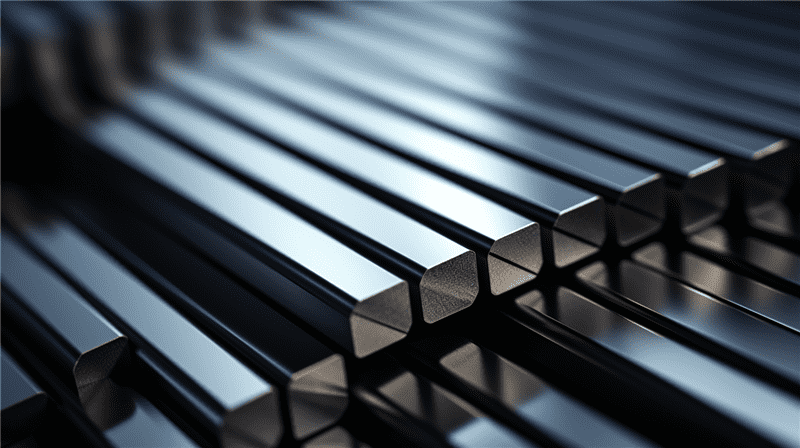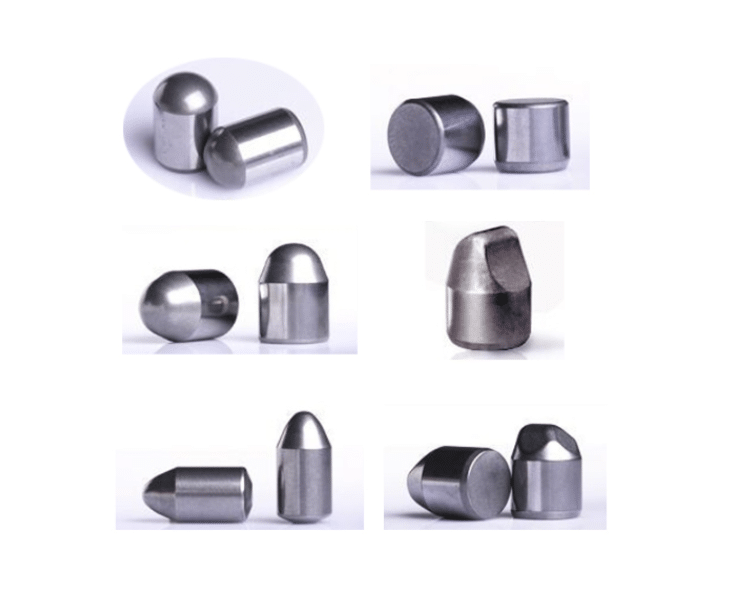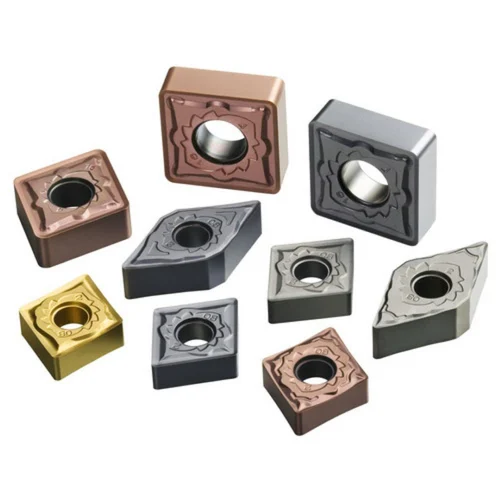Cemented carbide buttons provide extreme wear resistance across industrial equipment ranging from rock crushers and cutting tools to wire drawing dies. This guide reviews carbide grades, properties, manufacturing methods, quality control, applications, pricing and alternatives to inform buyers.
Cemented Carbide Buttons Overview
Also referred to as hardmetal buttons, cemented carbides classically describe powder metallurgical combinations of hard refractory carbides cemented by tough cobalt binders. Key properties include:
- Hardness above 1500 HV resists abrasive wear
- Compressive strength 2-3 times steels
- Refractory base materials handle temperatures above 1000°C
- Resists corrosion in acidic, caustic or solvent-based environments
- Cobalt adjustable from 6-25% tuning hardness against toughness
With extreme wear performance under high loads and temperatures beyond tool and stainless steels, cemented carbide buttons, studs and surface protection products defend critical equipment across mining, drilling, petrochemical, forest product and other industries experiencing impingement, sliding abrasion or high temperature erosion wear modes.
Cemented Carbide Compositions
Tungsten carbide (WC) forms the foundation of most commercial grades – largely supplemented by minority secondary carbides:
| Major Carbides | Description |
|---|---|
| Tungsten carbide (WC) | 88-97% typical. Provides hardness and wear resistance |
| Titanium carbide (TiC) | Typical 0-8%. Adds toughness and lubricity. Reduces material cost ratio |
| Tantalum carbide (TaC) | 0-8% substituting for more expensive WC contribute toughness |
Minor Additions
| Carbide | Impact | Use Levels |
|---|---|---|
| Niobium carbide (NbC) | Improves corrosion and oxidation resistance crucial for high temp niches | <4% |
| Vanadium carbide (VC) | Grain growth inhibition tailoring microstructures and mechanical performances | <1% |
Table 1. Common major and minor carbides blended into tungsten and cobalt cemented carbide alloys for tailored property enhancements
Manipulating WC, TaC, TiC with complementary niobium, vanadium, chromium fractions allows customizing wear resistance, toughness and corrosion behaviors matching button lifetime requirements across diverse equipment interfaces and mechanisms needing mitigation well above tool or stainless steels but below ceramics.

Cemented Carbide Button Properties and Characteristics
- Hardness – 1300-2300 Vickers (HV30) via fine WC grain dispersion and solid solution alloying
- Density – 11-15 g/cm3 depending on alloy ratios. Net shape quality cuts component weights.
- Strength – Compressive strength 4-9 GPa. 2-3X steel. Tensile strength half of compressive level.
- TOUGHNESS – Measure of mechanical integrity retaining sharpened geometries across cyclical loads and impacts. Cobalt and alloying additions crucial tuners.
- Modulus – 550-650 GPa elastic moduli akin to bearing steels supporting high unit loads without brinelling subsurface damage risks.
- CTE – Coefficients of thermal expansion ranging 3.5-5.5 x 10-6 m/K. Parameters considered during mounting.
- Thermal Conductivity – 60-100 W/m-K aids contact tip cooling when electrical discharge machining electrodes. Lower than pure metals but higher than comparative ceramics.
Blending and optimizing summed mechanical contributions from individual component material properties allows cemented carbides sustaining locally intense pressures, cyclical impacts and compound wear attack modes otherwise causing rapid failure in alternative protection materials.
Cemented Carbide Grades for Buttons
Dozens of commercial carbide grades available but simplify selection by differentiating carbon content shaping dominant wear mode protection – low(C), medium (M), high (K):
| Grade | Description | Total C Content | Key Applications |
|---|---|---|---|
| YG11/12 | Ultrafine grained. Good all-round wear + thermal/chemical resistance up to 600°C | Low C: 4-6% | Bushings, wire drawing, hot glass mold plungers |
| YG15 | Higher cobalt toughens against fracturing. Handles 200°C lower temperatures | Low C: 6% | Brick press dies, sizer crusher teeth |
| YG20 | Medium coarse grain suits moderate impact and abrasion resistance | Medium C: 8% | Ring granulator crushers, pulverizer hammers |
| YG6X | Mixed ultrafine/coarse grains optimize wear | Medium C: 6% | Hydrocyclone spigots, slurry pump casings |
| YG35 | Higher Ta, TiC carbides boost frictional wear behaviors | High C: 9% | Bucket teeth, shear blades, log debarking |
Table 2. Representative commercial tungsten carbide button grade families classified by carbon content manipulating hardness against toughness balancing dominant wear types – abrasion, adhesion, erosion or frictional wear
There exist no single optimal grade universally solving all wear problems – but rather define specific wear attack modes, loading conditions and failure risks to identify appropriate solution material resisting interfaces degrading premature component lifecycles from limited material technology choices centuries ago. Fortunately the continued competitive pressures within cemented carbide producers globally drives cost effective developments annually – meaning proven solutions likely exist today.
Cemented Carbide Button Manufacturing
Quality button fabrication processes require:
Milling – Ball mill pre-alloyed powder blends reducing particle agglomerates ensuring homogeneous powder distribution for optimal solid solution strengthening response across final components.
Compaction – Single action press up to 20 metric tonnes compacts milled powder reaching near full widget density without need for secondary binders. Isostatic high pressure compaction presses optional for higher uniformity and complexity geometries.
Sintering – Vacuum furnaces densify compacted shapes using capillary liquid phase transport mechanisms between cobalt and alloying elements. 1300-1500°C for 1-10 hours duration typical reaching >98% charge density – crucial to ensure closed porosity supporting cyclical loaded applications requiring fault free quality for expected lifetimes across grueling conditions keeping alternative material candidates struggling matching necessary cost-performance ratios required sustainability.
Grinding – achieve final dimensional and surface quality tolerances. Diamond grinding best suited to most carbide alloys reaching roughness values below 0.5 microns although risks pull-out damage in more skeletally hard/brittle grades preferring EDM contour machining instead although slower rates and higher tooling wear equates costs scaling less attractively as production volumes increase, a factor requiring careful consideration during initial component quoting and project lifetime evaluations.
Quality Control – verify chemistry, material integrity and dimensional conformance via optical metrology and computer tomography able to display subsurface defects needing elimination sustaining customer production uptimes preventing unplanned downtime service calls chipping away positive brand reputation and share-of-wallet loyalty built over years now potentially erased by single slipped batch of product allowed reaching field use missing the rigor required by the cemented carbide equipment protection industry compared to alternative material products historically allowing much wider quality variation tolerances going largely unnoticed lacking oversight.
Cemented Carbide Button Applications
Non comprehensive niches benefiting from extreme 1900 Vickers hardness, 4+ GPa compressive strength and chemical inertness up to 800C include:
Mining – Crushing, grinding, flotation and material handling equipment areas with especially Codelco extensively applying cemented carbide for decades now leading global copper production tons processed annually greatly reducing total operational equipment expenditures on parts and labor valued well above modest supplemented material acquisition costs only becoming more critical constraints each passing year as crews grow smaller, less experienced while mines push leaner yet chased by impatient investors no longer accepting quarterly misses – a radical shift in priorities now demanding senior engineers revisit initial plant designs seeking “lower hanging fruit” production bottlenecks upgrades missed earlier now paying compounded dividends preserving jobs during turbulent commodities supercycles testing true operational excellence separating best in class performers building sufficient internal financial reserves weathering prolonged talent recessions awaiting the inevitable commodity bull run returning when producers and suppliers whom prepared advance capturing greater market share gains over those crippled needing years rebuilding trusted relationships, skills and inventorories lost shortsightedly chasing recent zero based budgeting trends themselves shown repeatedly failing reviving operational capacities quickly during periods of sudden improved pricing. So truly if any question exists whether cemented carbides reasonably address real production and maintenance issues in mines, simply survey equipment engineers and product line management closer – sampling users who will quickly affirm lifetime cost savings summarized below:
Petrochemical – Flow control valves in cracking, coking and visbreaking units. Reclaimer bucket teeth. Solid particle erosion areas above superalloys.
Forestry – DebarkerCOMPONENTS and chip harvester wear zones formerly needing sheet metal stacks renewed weekly now exceeding years online with minor periodically scheduled maintenance interventions greatly improving logging equipment up and utilization rates historically dogged by hidden rework downtimes inflated by travel delays awaiting parts technicians making the business case rapidly improving TCO metrics and evacuated component upgrade ROIs self funding increased operator production bonuses, profit share plans and management street credibility stabilizing enterprise values shielding entire rural economies once vulnerable single mine/plant taxpayer concentrations.
Glass Manufacturing – Extreme temperature glass contact components like stirrers, plungers, orifice ring plates and discharge rollers where steel predecessors measured mere week campaigns now transformed into quarterly cycles reducing line changeover disruptions slashing furnace fuel and labor expenses yielding some highest cash payback investments available.
So in summary any component specification seeing extreme three body abrasion, metal-to-metal cyclic hammering, solid particle erosion, corrosive chemical attack or temperature fluctuations degrading alternative bearing steels, iron or bronze alloys within days or weeks pays exploring cemented carbide grades likely already developed commercially – needing simply accurate wear measurements and proactive vendor collaboration identifying root failure driver cost effectively elevating mean time between interventions maximizing customer production uptimes.
Cemented Carbide Button Suppliers
Leading international cemented carbide button manufacturers include:
| Company | Location | Description |
|---|---|---|
| Ceratizit | Luxembourg | Widest global carbide grades range including specialized nickel binder additions for chemical applications |
| Mitsubishi Materials | Japan | Industry leader providing own raw powder to finished components for quality control |
| Element Six | Global | Specialize in 90%+ ultrafine and nanoparticle reinforced grades |
| Kennametal | United States | Deep mining and mineral processing applications expertise |
| Sandvik | Sweden | Target small and hollow geometry components including indexable tooling |
Table 3. Notable cemented carbide suppliers providing button studs and customized wear component offerings
Dozens more local producers offer standard alloys but consider custom grades or application development needs requiring collaborative metallurgical partnerships afforded working alongside globally diverse innovation competing fiercely translates ensuring end user quality and pricing overall continually progresses – the fruits benefiting buyers lacking internal subject matter experts.
Cemented Carbide Button Costs
| Size | Price Range |
|---|---|
| Under 25mm (1 inch) diameter | $5 – $30 per button |
| 25-75mm (1 – 3 inch) diameter | $30 – $250 each |
| Above 75mm (3 inch) | Get Proposal |
Larger custom geometries match individual equipment mating surfaces optimizing component interfaces minimizing gaps impeding consistent force distributions introduced into carbide parts – crucial maintaining crack resistance finally determining actual button lifetimes justifying investments particularly cementing supplier partnerships capable delivering such offerings.

Comparing Cemented Carbides Against Alternatives
| Parameter | Cemented Carbide | Ceramics | Hardface Welding | Hard Chrome |
|---|---|---|---|---|
| Hardness | 1600-2300 HV | 2000-3500 HV | 550-650 HV | 1000-1300 HV |
| Toughness | Higher | Extremely brittle | Lowest | Low |
| Max Service Temperature | 1200°C | 1800°C | Approaches substrate | 900°C |
| Corrosion Resistance | Medium-High | Medium | Low-High depending on alloy | High |
| Component Size | Large | Small or coatings | Any weldable | Coatings only |
| Cost | $$$ | $$$$ | $ | $$ |
Table 4. Comparing cemented carbides qualitatively against alternative extreme wear material technologies
Cemented carbides sweet spot optimizing balanced hardness against component lifecycle costs while avoiding catastrophic brittle fracture modes plaguing oxide ceramics without post processing – whereas weld alloys introduce as-solidified micro-cracks degrading corrosion performance and ductility properties limiting widespread use.
So in situations beyond austenitic manganese or 400-series martensitic valve steels yet not requiring insulative electrical strength properties, fully dense alloyed carbide components merit consideration evaluating potentially gentler transition material savings opportunities too frequently dismissed lacking relevant data gathering homework disciplinary allocating specific production line items tracking such fleet “experimental” upgrades – delivering insights determining go forward upgrade policies.
The general guidelines – application temperatures under 800C with primarily sliding or erosive wear exposures likely benefit from upgraded tungsten or tantalum cemented carbide components whereas over 1000C or highly dynamic/adhesive wear modes steer engineers considering ceramics or specialized coating options instead – albeit noting lifetime financial risks growing accordingly so all material decisions cannot rely solely on laboratory simulated test results but also equally weighted field testing providing operator feedback ensuring sustainable transitions.
FAQ
Q: Can cemented carbides also apply using specialized coatings or treatments?
A: Yes frequently components apply thin multilayer ceramic, DLC, nitride or specialized diffusion aluminizing, chromizing layers boosting oxidation/corrosion resistance, solid lubricity, electrical insulation or thermal management properties unmatched monolithic carbide alternatives. Although coating thicknesses impose maximum service temperature limitations before interfacial failures limit total gains achieved so each layer requires compatibility oversight ensuring expected synergies translate during customer use without added risks.
Q: What causes cracking in cemented carbide buttons?
A: Fractures develop from tensile stresses exceeding critical thresholds arising from cyclic loading, uncontrolled expansions mismatches against substrates, or handling damage like drops or improper machining/grinding removing excessive edge material needed supporting compressive hoop forces preventing crack initiations quickly propagating within minutes across entire parts if unchecked. Managing risks requires fundamental shift ensuring quality controls help users not hurting them.
Q: Can tungsten carbides substitute tool steel machining applications?
A: Absolutely replacing tool steel inserts economical producing under 1000 identical components but higher material costs don’t justify usage above such volumes barring specialty micromachining niche exceptions. Progressive die and tool rooms best positioned quickly evaluating potential hardmetal benefits.
Q: How weldable are cemented carbides?
A: Quite challenging as alloys sensitize rapidly from stray iron or carbon impurities risking expansive cracking followed by accelerated corrosion ultimately undermining expected lifetime gains wished achieved so welded assemblies focus brazing/soldering or mechanical fastening connections instead – an artifact tracing early 1960-70’s false starts harming collective industry credibility taking decades slowly rebuilt through persistent education efforts by leading manufacturers worldwide aligner user requirements against lifecycle furnace proven capabilities testing application limits balancing performance against budgeting realities ALL stakeholders representing.




